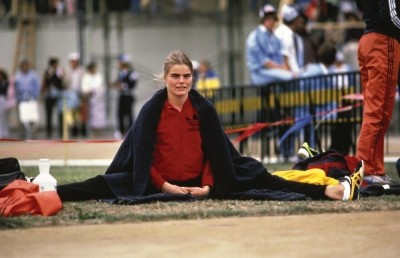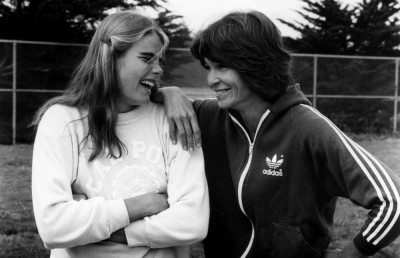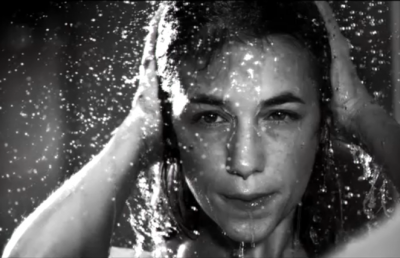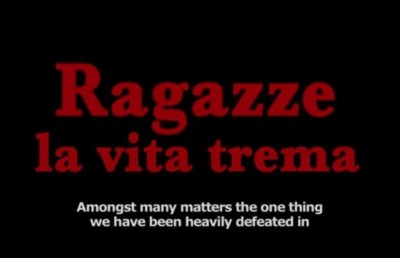Lars Von Trier’s Antichrist: Executioner at the Alter of the Other, Part 1
The Confessor and the Executioner
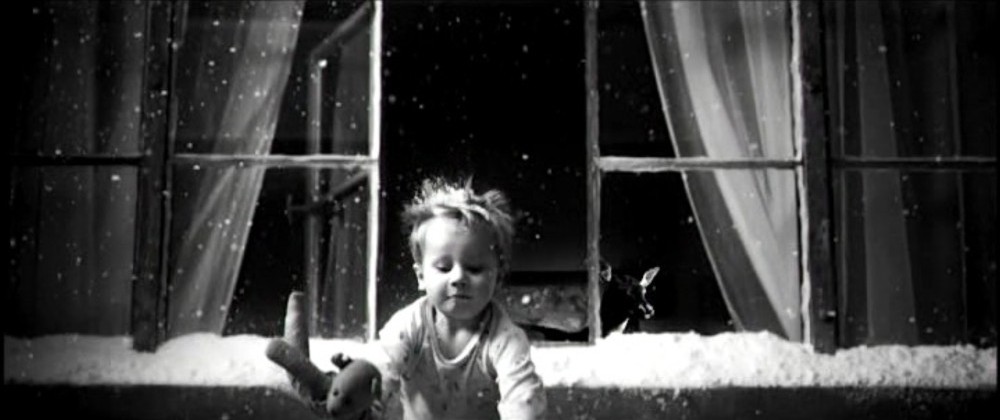
Lars Von Trier’s Antichrist studies domination and blame at both macro (historical, social, contextual) and micro (intimate, personal, isolated) levels. Many critics despise this film because as a narrative of gender, loyalties remain unclear, readable in several directions, and open-ended in an unsettling way. As Jill Lawless wrote for the Huffington Post, the film “left audiences at Cannes shaken, stirred and sharply divided.” The description of it as “misogynistic” trails in its shadow as well. Tom Charity, a reviewer for CNN Entertainment called the film “an atrocity” and says “the charge [of misogyny] seems to stick.” Contrary to mainstream reviewers who may cater to an audience trained by fetishistic and consumerist viewing practices that tend to drag sex and violence out of context, I would like to argue that Antichrist is unsettling because it depicts a kind of material history of gender violence played out through the demise of an intimate love tale. The story involves a husband going into isolation with his wife so that he can act as therapist to her after their infant son falls to his death neglected during a lovemaking scene between the couple –a tragedy so intense that the world disappears into their ecstasy. As they retreat into the woods to ‘heal’ her via a series of psychic exercises he has created in his adopted role, the landscape and animals that inhabit the woods, the ‘background,’ tells a parallel story. The couple that attempts to flee the distractions of the world dramatizes the world in the person, and the myth of solitude, or the idea that people can ever be independent of the world. The story debunks the myth of a history-less individual or a context-less love, reconstructing romanticism and intimacy as something that looks more like what The Invisible Committee have dubbed “the autism of two.” [1] In this sense the film is about the violence that takes place when context is disregarded, and inevitable psychological and historical backgrounds creep in to show that the settings of society and the world cannot be removed; or that when the removal of the world is attempted, it returns in another form, as a past of human power relations that radiate into the present. Part of the film’s myriad of explicit and implicit messages is that there is no place or being in a vacuum, no individualism. In a way neither is there an affirmation of privacy nor private property because the forces of nature which, in the modernity of Francis Bacon, were always supposed to have yielded to ‘Man’ are here given a voice. [2] The animals and ghosts that roam the woods of Antichrist articulate a resistance to mastery through “chaos.” Antichrist can be understood as a narrated episode not unlike Joseph Conrad’s Heart of Darkness, in terms of Willem Dafoe’s ‘He’ character reconstructing the events that led up to the annihilation of his wife. In this context, the story can be seen to unfold on two levels. On one level it is as an isolated domestic drama. On another level it repeatedly conjures a background of disavowed passion and violence that invoke the coming into being of gender via the history of witches, gynocide, and the question of ‘nature’ in a form that prefigures modern notions.
Mainstream reviews have been quick to point out that Antichrist has a mythic and archetypal quality as a result of the cast being limited to two characters, a man and a woman, who are never named. As a result of a drama of two (between ‘She and ‘He’), the mise en scene is exclusively filled with a sense of allegory and isolation. The focus on He and She functions to outline a philosophical and historical conflict between what could be understood as male and female power as well as the emergence of male dominance. [3]
The story follows husband and wife into a violent psychological inquest revolving around He’s mandate that She, the grieving wife, must face her fear in order to integrate grief. But in contrast to the central role of her grief, it is significant that his is rarely mentioned. Within the first chapter of the film entitled Grief, she tells him “you are indifferent to whether your child is alive or dead.”
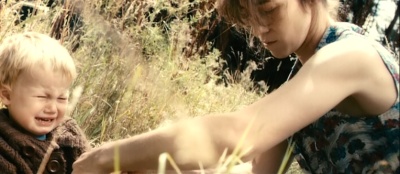
The denial of He’s grief is crucial for understanding what is involved in him playing the role of therapist. To understand how his disavowal operates, Erich Auerbach’s 1946 literary notions of “foreground” and “background” in Mimesis are useful. In a comparison between the Odyssey and the story of Abraham and Isaac, Auerbach creates definitions of the Odyssean style of “foreground” as that which “is scrupulously externalized…in a local and temporal present which is absolute…orderly… self-sufficien[t]…patriarchal…” He further describes the Homeric text as:
A realm where everything is visible; and not less clear –wholly expressed, even in their ardor – are the feelings and thoughts of the persons involved…Homer does not omit to tell the reader that it is with his right hand that Odysseus takes the old woman by the throat to keep her from speaking, at the same time that he draws her closer with his left…The Homeric style knows only a foreground, only a uniformly illuminated, uniformly objective present. (Mimesis 3-7)
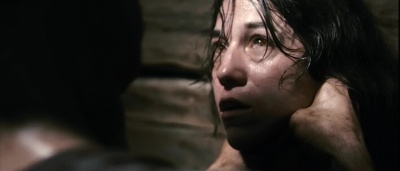
In a contrast description of texts shaded with background, he describes:
The Jewish writers are able to express the simultaneous existence of various layers of consciousness and the conflict between them…a great number of contradictory motives in each individual, a hesitation and ambiguous groping on the part of groups…In the story of Isaac, it is not only God’s intervention at the beginning and the end, but even the factual and psychological elements that come in between that are mysterious, merely touched upon, fraught with background; and therefore they require subtle investigation and interpretation, they demand them. Since so much in the story is dark and incomplete, and since the reader knows that God is a hidden God, his effort to interpret it constantly finds something new to feed upon…Indeed [such texts] are in constant danger of losing their own reality, as very soon happened when interpretation reached such proportions that the real vanished. (Mimesis 15-17)
Using a comparison between two styles of ancient text, Auerbach opposes a “foreground” narrative prevalent in the writings of Homer that comprises a flatter sketch, yet “charming” through its orderliness, clarity and ageless, immortal ‘heroic’ time fixed in the eternal present, against the Biblical text fraught with “depths of time,” consciousness and contradiction, but also layered in so much interpretive potential that no version of the real can maintain authority over others. Auerbach’s link between the “foreground” as starkly illuminated Homeric text, with the heroic man Odysseus stifling the voice of the old lady, seems also significant. The foreground narrative can be associated with simple, schematic and mainstream tales such as those in mainstream cinema. In this contrast between narrative styles, Auerbach’s view foreshadows a certain kind of vantage point on film which comprehends the patriarchal leanings of a foreground style, a hand on the throat, which places women inside the story as objects of criticism or fetishism, but not as storytellers. Along these lines Kaja Silverman’s still relevant 1986 essay “Disembodying the Female Voice” describes how the women of mainstream narrative cinema remain embedded in the plot line, but do not emerge themselves to produce meaning. She says
The female subject…is associated with unreliable, thwarted, or acquiescent speech. She talks a great deal: it would be a serious mistake to characterize her as silent, since it is in large part through her prattle, her bitchiness, her sweet murmurings, her maternal admonitions, and her verbal cunning that we know her. But her linguistic status is that of a recorded tape, which endlessly plays back what was spoken at some anterior moment, and from a radically external vantage. The participation of the male subject in the production of discourse may be limited, and contingent upon his “willingness” to identify with the existing cultural order, but the participation of the female subject in the production of discourse is nonexistent. (“Disembodying” 309-310)
This range of Silverman’s description of women, from unreliable, thwarting, and bitchy all have in common that they present a ‘problem.’ In Silverman’s understanding, the women of mainstream narrative cinema create a distraction or complication to the advance of narrative. For her, women are not producers of discourse but await a discourse to be produced about them; they are therefore problematic and Other. This placement of women’s roles within mainstream narrative, which has many features in common with Auerbach’s description of foreground narrative, is important for understanding how the narrative of Antichrist attempts to advance as a therapy story but becomes thwarted, contaminated and made chaotic by an encroaching “background” of nature linked with a female voice.
If Auerbach describes both foreground and background types of text as emerging from patriarchal social orders, he emphasizes the presence of the dominant maleness in the straightforward linear and implicitly mainstream narrative progression of the heroic Homeric text, linking visible orderliness with control, domination and the adventures and explorations of men. In contrast, the background text is shaded by angst and personal complexity, layers of mood and sense of a past; those aspects of narrative or engagements between beings imagined in psychic life, but that are not necessary for the narrative to advance are, in Silverman’s terms, markedly feminine and appear to thwart such progression.
In Auerbach’s terms, Antichrist tells both kinds of story in conflict with each other. In a very schematic way, it appears that the foreground story (the iterated journey to heal) is the domain and narrative texture of He, while the background (the creatures and the articulations of the woods) is that of She, even if, ultimately, He, as narrator, is constructing both of them. Although He’s ordering gaze proposes the illusion of a balanced view, the film’s diegesis does not. For it must be emphasized that the entirety of the Antichrist is He’s story. There are no scenes of She alone that are not revealed as narrated by him, but there are scenes of He alone. Antichrist is told as a series of memories divided into chapters (Prologue, Grief, Pain, Despair.) Even more significantly, the sense of She being in league with ‘Satan’s’ nature while his terror seems to control the frames of the film’s sense of time, as well as Von Trier’s own admission of being in a post-separation depression, all suggest a limit to any pretence of providing a “balanced” view of the conflict between He and She.
Moreover, He’s story –the linear advance of the narrative about therapy– is what structures the diegesis, or attempts to. But unlike a mainstream film, neither She nor her story is fully containable as an object. For her story not only inflects but harasses and intimidates his. This background associated with She does not just thwart, it actually alters the trajectory of the foreground. His agenda of going to the woods to heal is a dry, rationalistic undertaking that involves his control over her: an attempt to contain her within the story by submitting her to various exercises he has created. But the story that advances regarding her healing never succeeds. In fact, it seems that he succumbs to an hallucinogenic state that expresses his failure to control her or the narrative. As the fox utters “chaos reigns” it becomes clear that the Eden landscape he had in mind is anything but submissive. This, I would argue, is where Von Trier’s Antichrist is not simply a misogynistic tale, but a deeply reflexive account that underscores the gaps, contradictions and cracks in the simplified foreground and emphatically male account. It is, in a sense, the story that a man might tell to himself just as that story is falling apart. If He finally ‘solves’ the problem of She by strangling her at the end, He is implicated in more than murder, but in gynocide. Von Trier invites a discussion of the witches and en masse killings with this simultaneous cover up and confession of murder. This detailed, tortured, simultaneously excused, meticulously reasoned and self-exposing confession of femicidal guilt cannot, in any simple way, serve a misogynistic agenda.
Auerbach’s choice of the foundational and ubiquitous Abraham and Isaac story for what constitutes a background narrative style is also relevant. In that foundational story about Abraham’s conflict, God tells Abraham, “Take your son, your only son, Isaac, whom you love, and go to the region of Moriah. Sacrifice him there as a burnt offering…” This conflict of sacrificing the son to God can be seen to correspond with Antichrist’s opening scene where the infant son Nick falls out the window right at the moment of She’s climax. It is as if the son had been sacrificed to God in the temple of sexual ecstasy. In the connection to this foundational biblical story already lies a possible motive for He to remove himself from the husband role. In the ancient and archetypal Abraham and Isaac story, the act of the father killing his son to demonstrate his devotion to God’s request emphasizes the problem of split loyalties. Moreover, the story of Abraham and Isaac characterizes Auerbach’s notion of background partly because Abraham’s conflict is expressed more fully by God than by Abraham in “your son…whom you love.” Analogously, in Antichrist, the dead and beloved son hangs in the echo of Antichrist’s background as that which cannot be overcome, or that which can only be overcome in defiance of Nature. Like Abraham’s God, Nature seems to comprehend the depth of the conflict more than the father does. [4]
Both He and She make sketches that could be understood as maps of the cosmos. He draws a flat pyramid sketch to render a diagram of her fears. This rough drawing appears early on in the film when the foreground narrative of therapist and patient still has control over the narrative. The sketch is a quick doodle on a pad with blank spaces starting from the bottom and advancing towards the top. He writes “Eden” in the center during an exercise in which she shuts her eyes and retreats inwards to answer a question he poses to her regarding the location of her greatest fears. Later, when she describes the forceful breeze from the window as “Satan’s breath,” he shuts the window, and writes “Satan” down on his list. But he almost immediately crosses it out as a viable fear, or something that fits within his order. For ‘Satan’ is too much of a background concept, a non-concrete, metaphorical and irrational construct, to fit his schematic. Yet writing down “Satan” foreshadows his writing down “Me,” as in himself.
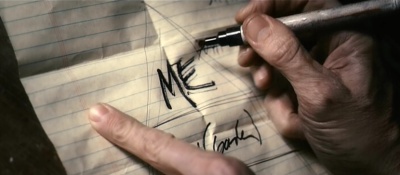
Moreover, He’s pyramid structure could be read as a drawing of his cosmology: a monotheistic regime that awaits the determination for the power at the top to be named. Like Nietzsche’s Anti-Christ, He’s decision to play therapist is also what she calls “arrogance,” a rejection of her plea to “trust others to know more than you.” [5] When He finally names the top power at the very end of the film as “Me,” the denouement begins, and the couple transforms from lovers to enemies, finally playing out the historical event of the violence between confessor and witch.
Her sketch, in contrast, is far more complicated. It appears embedded among her drawings and hand written thesis notes kept tucked away in the attic. Her cosmology is chaotic. Rather than being ordered by one God, she names three beggars as constellations. Her sketch appears much later in the story, only after the chaotic background –the landscape populated by a half warning and half threatening fox, an immortal crow and a miscarrying deer overwhelm his orderly perception and narrative imposition. Drawn in her sketch as constellations the fox, crow and deer take on the broader classical meaning of that which remains for eternity: three emotions etched in the sky representing the banishing of emotional life, exiled to the other plane of background, where they hang remembered, both ignored and impossible to ignore.
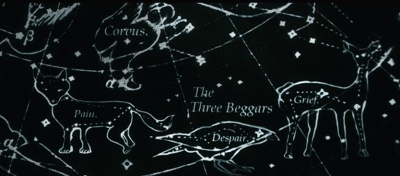
These sketches can be seen not only as diagrams of the cosmos and Eden, but also of He and She’s rendition of the Other. As in classical philosophy, earth, gods and mortals are mirrors of each other. He’s pyramid charts a hierarchy of her fears, suggests a sketch of her psyche, and diagrams the reason for bringing her to Eden. Meanwhile her sketch of three constellations reveals what will unfold, her confrontation with him, and his experience of horror in the form of the three beggars who represent grief (in the form of the fox), pain (the deer) and desperation (the crow), but are only revealed as the animals in the wood at the very end of the film. This scene at the end is referred to in the mental exercise on the train where she passes the fox’s hole of ‘grief’, as well as in hallucinogenic moments and panic attacks that he describes as transitional for the journey of ‘healing.’ I shall return to discuss these two pivotal moments, the ending and the exercise that forecasts it at various moments throughout this analysis.
With regards to the way the narrative advances under his direction and agency, the linearity, hierarchy and pyramid of her fear, all suggest a kind of schematic and formally advancing trajectory regarding grief and healing. Meanwhile her reactions in concert with the articulations from the landscape form a background that recognizes that his healing disguises his control. The heroic and adventurous way He undertakes his task further begs the question of how he understands what she is – a landscape, a mother, a submissive, a student or a witch – or what he himself is, an immortal capable of instant recovery from grief and the close proximity of death. The rationalistic, immortal hero therapist who does not feel grief and is “above” pain, invokes the heroic Odysseus so loyal to the conquest that his domestic identity becomes unnecessary, cumbersome, and obstructive.
Like both Odysseus and the Marlow of Heart of Darkness, understood as part of the trajectory of Odyssean influenced tales, He sets out on a mission to discover the dark continent. That said, Heart of Darkness has a background: Marlow’s voyage up the river to find Kurtz yields an encounter with Kurtz’s “horror” of the realization of how the empire exists in the self even in the heart of Africa. The darkness of Africa is implicated in the darkness of Kurtz’s complicity with the imperializing project. [6] Just as Marlow finds Kurtz’s imperializing power at the core of Kurtz’s horror, so does He find her power horrifying. And although He’s narrative texture tries to render her insurmountably dangerous and evil, the horror of She is referential, but not parallel to the imperializing horror of Kurtz. His encounter represents a similar kind of anxiety of Otherness, but what He uncovers at the heart of She is the pain of the colonized, not that of the colonizer. Since the colonizer must resist empathy and/or its consequences, an encounter with the colonized that reveals her experience of pain represents the most palpable of threats. Like the heroes Odysseus and Kurtz, He overreaches his own power in what has to be understood not as the exploration of the earthy “dark continent” but Freud’s “dark continent” which, in the psychological environment of the nineteenth century, constructed women as hysterics, problems to be solved, as eternally Other. Along these lines Rhanjana Khanna has argued that “psychoanalysis is a colonial discipline…situated itself with fascination, in opposition to its repressed, concealed, and mysterious ‘dark continents’: colonial Africa, women, and the primitive.” (Khanna 6)
Behind He’s foreground, the background of She gathers tension, forms apparitions, occasionally speaks, heeds warnings or produces its own sub-plots. In a recurring shot, the cabin-style country home is often shown set against a sky that sits fixed behind the low rolling clouds of dawn or dusk. The isolated lonesome log cabin is planted in a small clearing, and surrounded by seemingly endless foliage and forest. The sense of isolation, and the vulnerability of the cabin appear in its log construction, its rectangular sparseness from the outside, and the brown and grey shadows that compose prolonged impressions of late twilight or ‘timeless’ time. The lighting is otherworldly throughout most of the film. At times, the image appears burned into a negative; the raw schematic of a photo with reversed light. It also visually recalls Ingmar Bergman’s The Devil’s Eye, a light and humorous romance about Don Juan coming back from hell to seduce a virgin, and in the process becoming overwhelmed with love after having to revise his concept of virginity upon learning that the virgin had seventeen unconsummated lovers before meeting him. The scene by the house of Antichrist recalls scenes in The Devil’s Eye where the narrator stands near a whited out tree, seemingly outside of heaven and hell, while he muses over which direction the plot should take. Though a comedy, The Devil’s Eye renders the devil as being overwhelmed upon encountering the Other in the form of a virgin who has experienced too much, and thus muddles his categories. As a result the plot becomes uncertain.
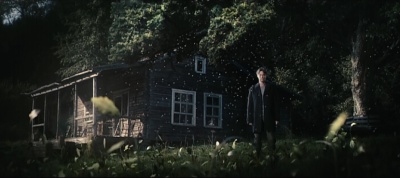
In She’s premonition of the ending induced by He, her image is bleached out and ghostly, lit like a flash from the future or the past. The anti-space or negative imprint contrasting with the muted foliage seems to produce a sense of “in between” light and time; like Auerbach’s vanishing real, these images produce the kind of environment where ‘what is actually happening’ has no greater status, concreteness or legitimacy than any other phantom or dream. The trajectories that get associated with reason seem, in this in-between, held in mid-space and not yielding to a linear advance, are no longer engaged with one god ordained by Christianity, but with many possible gods that lurk in the woods. With the clutter of community and the collective reality of urban society absent, the collective historical background begins to speak alongside the psychic background of the self.
Such a total immersion into the background of psychic space might sound ideal for the therapeutic goal. But images of She having panic attacks, which include blurred out images of body parts and fragments of a chest pulsating to the sound of breathing, suggests a camera as eye rather than lens, emphasizing panic more than an impartial gaze. The perspective is too close and too fitful to be rational or objective. If the therapist were actually a figure with some personal distance rather than a husband, such a thorough immersion into the psychic interiority of the other might not be possible. For at times, she walks in the landscape and describes it in a manner that seems completely transparent to his understanding. During the mental exercise he gives to her on the train on the way to Eden, She appears to be alone. On his vocal cue, in her mind she materializes in Eden before their physical arrival. She gives her descriptions to him on cue, passing the foxhole where he will later undergo a confrontation with despair, and be dug up by her as she realizes that he had not been healing her but hiding from her. As the film’s hidden narrator, he perceives himself as having an absolutely integral position within his wife’s emotional life. He has the capacity to see her imaginings and to construct them. Still, even in those constructions, parts of what is not him seems to get through. For instance, during an exercise he gives her prior to arrival in Eden, he asks her to imagine being in Eden and then he instructs her to lie down on the green.“On top of all the plants?” She asks in a terrified voice. It is significant that she describes the clearing as plants, while He uses the more unitary idea of “green.” “Yes, lie down on top of the green.” He then asks her to “turn green.”
Her concept of plants refers to an individuation of different beings and species in nature, and a fear of crushing their lives. His idea of “green” does not recognize this differentiation. His request, to “turn green” worded as such, can be understood as him trying to use his simplified construction of what comprises the clearing to immunize her against seeing the intricacies of a more multiple landscape. In this sense, he asks her to become one with his unitary vision, and to crush or lie down on top of her own more multiple one.
This control, where he recesses into her mind and watches her thoughts as if from a hidden camera, is what makes the background overwhelm his orderly narrative advance. In constructing her mind, he becomes overwhelmed by it. By being inside it, he cannot order it, or escape its background layers. The elements that She is frequently aligned with —the orgiastic sex, the violence of nature, the multiple small gods and omens, the fox, crow and deer, and the acorns that pound on the roof all night— seem to be exactly what He cannot avow or enter into a dialogue with. These beings all appear to him and stun him to silence and fear. But for She, the acorns are the tragically dead offspring of the tree; the crow seems to speak to her directly; and the fox, the crow and the deer appear already as beings she has known well enough to understand the emotions they represent. She has a relationship to these disparate and differentiated elements that make him feel out of control. He can only see them enough to disavow them.
After their arrival in Eden, the slowing down of the sequence of frames when the fox utters “chaos reigns” places He, along with the viewer, in a totally alienated relationship to order, God, power, nature and time. The utterance “chaos reigns” is stated in a warped slow motion, out of time and synch with the visual frames. It destabilizes these foundational aspects of “normal” experience and creates an “in-between-ness,” the sense of something that is not supposed to be there. This ‘extra,’ the “chaos” disavowed by He’s ordering perspective, scratches distractedly at its own symptoms without being able to connect them to the affect that falls outside of his framework.

What type of a therapist can inhabit the psyche of the other, that background of depth, contradiction and angst which the therapist is supposed to seek, but must disavow it for his own reasons? In order to play therapist, his own grief and mortal relation to the tragic death of his son must be kept at a distance and hidden. Without acknowledging his own relation to the background, he can only advance as a schematic adventurer. To pause and recollect, to acknowledge or explore his own terror, is to recognize that there is no controlling the grief process for himself or for another, or to recognize his own guilt and angst in the irresolvable problem of Abraham and Isaac. Yet to seek control over the Other or the self may even be considered symptomatic of the violence of grief. Moreover a therapist cannot be committed to a simple advancing foreground narrative. This is to suggest that playing therapist in such a context can only be on the agenda for the needs of that therapist’s grief, not an agenda of the Other’s healing. This would be a kind of therapy, or at least ‘process’ for the therapist, not for the patient. Moreover to disavow in the psychic space of the other, to proceed with a foreground story while the background is trying to speak is to commit a grave act of violence. By moving into the depths of the Other’s psychic interior, and ordering behavior in that realm of the therapist’s own reasons and convenience in response to his own guilt and fear, his own denial, is not to play the role of therapist but to play the role of confessor. For unlike the therapist, at least ostensibly, the confessor has an orderly purpose and legal agenda that a therapist is not supposed to have. In this sense, He’s study of her is an act of repression and violence, a gagging of those crucial elements not only of grief but also of Otherness, of the elements of the Other that defy his narcissism and speak without interview and without legitimate or ordered ‘place.’ Like Odysseus, with one hand he pulls her closer, with the other he puts his hand on her throat to silence her. Acting as an explorer, He encounters the “dark continent” of Eden and of She, searching for a key but finding only “the horror” of his inability to control her, and the kind of violence involved with his attempt. It is not only the landscape but the difference of the Other that reflects back to him a surgical control of the emotional and psychic interior gone wrong, abscessing, miscarrying, and chaotic.
His linearity and rationalism can be understood as a metaphor for monotheism. Monotheism both mirrors and is mirrored by feudalism in its very structure of the rule of the one over the many. Her ability “to hear the screams of all that will die” in the acorns, or make love to him among hands that grow out of the earth to join each other and She to them, indicates her relationship to multiple gods, her empathic relation to the landscape and with nature and the witches that she studies with informal scrawlings and drawings. Both historically and philosophically, She is He’s “natural” enemy. The rebelling background of the feeling and being that falls out of his control, permission and agenda speak in part for her unconscious knowledge of his hidden inquest of her Otherness, his production of imperial, centralized, monotheistic, accumulated morality, and finally his intention to pass judgement, to philosophically reduce from the multiple to the One, and to mete out blame and punishment at the conclusion of an inquisition masquerading as a therapy session.
Antichrist establishes early on at the funeral that no one, no account of law, or account of the events finds anyone guilty. Nonetheless a philosophical battle unfolds between He and She around the experience of grief and the role of blame. The psychic guilt in the film seems to appear by stealth, standing in for the fact that the exterior Law, represented only by the funeral which operates as one of the few instances of public and ‘civilized’ life, finds no one blameworthy. The funeral appears as part of the foreground, but the faces of the people that comprise the community of mourners are blurred out because as the storyteller, He finds the reactions, suffering or empathy of the other mourners meaningless.
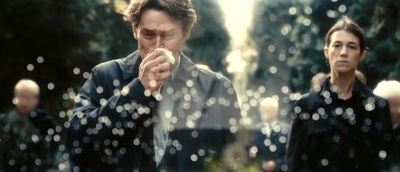
Perhaps the foreground narrative of He creates this scene to show that without a judgement coming from the social world, the psychic one tries to compensate, and produce its own blame. It has its own inquest and its own trial because the interiority of the individual is the real experience that eclipses all others. From this perspective of an ‘internal’ inquisition, he can then show how his wife confesses and demonstrates her own evil.
In this respect, a pivotal moment arises when he shows her the photo of the child wearing backward shoes. The backward shoes are linked to an x-ray taken by the coroner showing that the child had deformed feet. In film noir, the coroner’s report is often linked to an inquest over the crime of murder. By showing She the photos, He suggests that there is something wrong with her performance as a mother. Because the child’s feet were deformed, it follows that the child had worn backward shoes not only on one day but on many. Placing the photo before her as if to imply the obviousness of the evidence of motherhood gone wrong, He seems to suggest that only the person putting the shoes on is responsible, that there is no negligence involved whatsoever in the fact that he never noticed backward shoes, or that he never participated in dressing his son. When He presents the backward shoes to her without any acknowledgement that he might himself have been accountable, the plot shifts. This shift occurs despite She showing no major reaction. She in fact describes the incident as “absent-mindedness” on a particular day. Significantly however, this evidence of wrongdoing turns her from a patient to a suspect. It suggests her link to the crime of infanticide. Understood as such, the project of healing begins to expose itself as an alibi for his desire to have control over her and to understand what happened from the position of confessor or judge, not healer. He hints at his confessor role when he reminds her that he “was there too” for Nick’s death. Moreover, by removing himself from the role of husband, he becomes above suspicion and immune to the possibility of blame. At the same time, the therapist role serves as a conduit for the confession because the therapist can be understood as the modern day liberal transfiguration of the priest or confessor. [7]

His first attempts to play her therapist may appear as attempts to withstand her grief rather than control it. Then after he appears unable to resist She’s sexual advances, his role becomes more stoic. “This won’t do,” he mutters to himself. His abstinence from sex and his rejection of her in this capacity is based on his own disavowed guilt. After he loses control and ends up fucking her, he ramps up his excavation of her fear. He manages his own guilt by forbidding sex. Sex has to be forbidden because it is tied up in the death of the infant son. It is tarnished by her climax during Nick’s fall. Of course, the viewing audience knows that because He was so involved in the sexual intercourse of the opening scene, and presumably in a different room, he would not have known that Nick fell just as his wife climaxed. But the scenes are cut together to show the temporal parallel between the climax and the fall. The parallel has to be read in terms of the work of He’s imaginary projection as he manages his own guilt and shame by renouncing desire.
This impersonal search to satisfy guilt which seems to necessarily preclude sex also serves the purpose of hiding their differences. These differences can be understood in terms of the following: Her studies focus on witches, and her sexuality is Dionysian. Her grief experience is collective: She “hears the screams of all that is to die” in nature. Her experience of grief is embodied. She appears to respond to the trauma of Nick’s death by attempting to recover sexuality and ecstasy from it, by being drawn to sex and desiring it. In contrast, He responds to the trauma with guilt and abstinence from sex. When they finally have sex at the root base of the tree, multiple hands reach up from the earth to join with her. The hands form a cradle around her body. This image suggests that for She parts of a multiple and collective self are placed in the sexual act. But for He, this multiplicity is terrifying because it suggests her pleasure in the death of the son. For her, according once again to his imaginary that constructs the entire narrative, including She’s perspective, sex is not a solitary or private experience, but a place where guilt, fear, loneliness, rejection, self-hatred, greed, and pleasure partake of the same sacred ritual that for him is supposed to be governed by the more acceptable experiences of love or intimacy as an isolated couple. When she expresses her desire to be hit she also expresses an inclusion of violence to complete the communication with conflicting longings. His initial refusal to hit her, and his association of sex with guilt represent a more ordered self control by a hierarchy of permissible and banished feelings; the performance of intimacy that leaves the unspeakable to long, starve or turn in on itself.
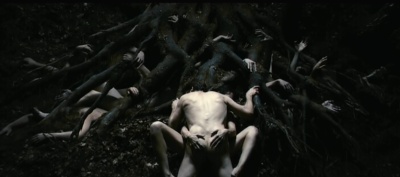
Even more pressing than the inclusion of this multiplicity within the experience of sex seems to be her need to include them as expressions of the present state of their emotional love bond. When she asks him to hit her, she is also asking him to express the truth of the confessor underlying the therapist’s role, to bring his implicit disavowed background control and violence into the physical and embodied desire to be hit. In trying to construct her as a masochist, this element of her desire punctures and stains his rendition of the events. For She’s desire to be hit could also be read as an effort to work out his ‘therapy’ of hidden mental control, his power as confessor, in the realm of pleasure rather than pain; to use the body to dramatize and therefore heal the power relation between confessor and witch; to heal the ancient wound and transform it by avowing the existence of opposition and combat in the lovers’ terrain of the flesh. This desire to embody conflict rather than disavow both conflict and the body represents a crucial difference in the approach of the confessor (who is also the executioner) and the witch. He has to represent the differences between them in order to demonstrate her Otherness, but in doing so he cannot help but also represent their conflict.
There are elements of the sadistic in the idea of the confessor disguised as a therapist. It is likely that the sadistic elements of He’s character were clear to Von Trier when he asked Charlotte Gainesbourg to prepare for Antichrist by studying Charlotte Rampling’s character in the Night Porter, a seminal film on sadomasochism. [8] For Gilles Deleuze the sadist instructs and inflicts his power, knowledge and world view on the Other. He does so without the need for approval from other forms of authority and without the need to contest them. The sadist does not and cannot recognize the needs of the masochist. He “instructs” and foists his worldview on the Other; he does not give pleasure or ‘see’ from a view (or feel from a body) other than his own. His system is enclosed and narcissistic, solitary and isolated. The sadistic instruction via shame and guilt tries to push out the world and evade all competing authorities. [9] Likewise He’s rejection of the hospital and the other therapists, his throwing away her pills, and calling into question the therapeutic authority she is under indicate his rejection of the Law, as well as her desire for him “to trust others.” But at the same time, the creatures of the landscape’s woods puncture the reality of the sadist qua confessor qua therapist. As Bersani and Phillips write, “Guilt, and particularly shame, however unconscious are fairly and squarely in the realm of the social, of the official and unofficial social contract.” (Intimacies 111) Blame and guilt are part of both present and historical social contracts but also show how the experience of them is grievingly, painfully, despairingly isolated and solitary.
It should be noted that role playing in and of itself does not appear to be the object of critique here. If anything, Antichrist troubles the concept of appropriate roles by making this move from husband to therapist seem a totally plausible and reasonable practice, in the beginning at least. It is possible to infer from this and from the introductory love scene that re-situates parents as lovers, an opening up of the impossible mandate of appropriate roles. To these ends, Bersani and Phillips have described the analyst as the dream of a kind of ‘relationless relation’ brought about by the possibility of an impersonal intimacies. They say
No amount of redescription will alter the fact that if people can satisfy each other they can frustrate each other. The impersonal narcissism of the psychoanalytic relation is, whatever else it is, a training in bearing frustration without resort to violence. (Intimacies 109)
According to this, playing therapist is a common and casual practice of human relationships. For indeed “bearing frustration without resort to violence” must long predate the inception of a formal therapy practice. Yet such a “bearing” has become institutionalized and recognized as therapeutic. For in fact, human relations and language are riddled with polemics, places and people that may or may not fit the Other they are meant to address according to the script of the Other’s socially designated role. If anything, Antichrist suggests that such social roles shift not as exceptions but as rules, i.e. from witch to wife to patient to student. These are not just her social roles, but specifically roles that She plays with him. His idea of the therapist is problematic because it is linear and ordering, prescriptive and surgical in nature. It surgically separates reason from feeling and is also asexual. It is also fixed and does not allow for fluctuation back towards the husband role. This fixing of roles represents the attempt to escape accountability and feeling, and finally to impose power, blame and punishment; to inflict coldness, authority and stoicism, and to escape the aspects of the body that cannot be controlled or mechanized.
Gainsbourg’s character seems to attempt to internalize his therapy, control and monotheistic sense of cosmology and power. When He discovers the notes from her thesis work on gynocide and questions her about their content, she responds by confirming a prosecuting Christian line on the evil of witches and the need to have them killed off. His response is to lecture her about “what should have been a critique.” Here again he is presented as a hero who, on the surface, appears to be defending the modern liberal stance on the witch burnings and gynocide. But in the tone of his voice, he is dictating her thoughts and contesting her findings. His condescension and the command forms he uses show that he assumes control over the administration of power and knowledge. She self-persecutes by philosophically colluding with gynocide and showing complicity with a persecuting medieval view of the witches. Here again, it is He’s story made viable by the witch herself who confesses after being confronted with evidence. It is relevant that she confesses in isolation, under duress and the direction of authority. In this way, the film’s audience is led into his defense argument that prepares them for his torching of the cabin with her in it in the final scene.
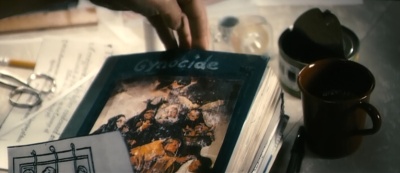
To go further, his rendition of her involves expressing that had she accepted his liberalism, she would remain under his control and persecution. Instead she chooses to self-persecute. An irony appears here. To take the modern liberal view of gynocide is to yield to his authority. But her affirmation of the evil of witches to him mocks his authority and displaces his power. The displacement of his power, the decentralization of it articulates her relationship to the background and enacts a negation of the monotheistic structure. Likewise, when She says “women don’t control their own bodies, nature does,” her loyalty to the collective voice of nature becomes clear. But at the same time, the foreground of He distils her allegiance to nature-as-multiplicity into a confession of evil.
The self associated with a multiplicity of experience that speaks with the collective voice of nature – the animals and elements– repudiates a biblical and monotheistic ideal of nature as harmonious, peaceful, silent or enslaved to a natural order. In her groundbreaking work on the witch hunt, Caliban and the Witch, Sylvia Federici explains, “The woman-as-witch…was persecuted as the embodiment of the ‘wild side’ of nature, of all that in nature seemed disorderly, uncontrollable, and thus antagonistic to the project undertaken by the new science…” (Federici 203)
To understand what Antichrist contributes to a discussion of blame, the historical context of the witch trials requires further explanation. Federici’s account of the witch hunt relates it to the co-emergence of modernity and capitalism. She details the persecution of witches, at its height during the emerging capitalism of the 16th and 17th centuries in Europe, as in part an attempt to control the influence and philosophical difference of the witches from the emerging rationalism that was reconstructing the body as a work machine in order to make laboring bodies more efficient for the profit of their labor and land-owning masters. [10] Federici associates the emerging concept of the witch with the church’s accumulation of power over women’s bodies and reproduction. According to Federici, after the black death, landowners including the church concluded that the economy of waged work could not be controlled unless future populations of workers could be insured. In this period, non-reproductive sex became a crime, non-child producing women, sex workers and career women, or women who were not bourgeois mothers, were criminalized. Between the 16th and 17th centuries, tens of thousand of women were charged as witches, frequently around accusations of infanticide, or participation in a so-called witch’s Sabbath, where women may have practised beliefs or healing arts that went against the New reason of Hobbes and Descartes that mechanized the body as a work machine. They were charged with eating and killing children, participating in orgies and other forms of falsified and exaggerated excess and were considered threatening to the aim of the reproduction of a worker class. It is likely that witches were feared because they held beliefs and powers that had the effect of unifying workers, land and nature against employers who were privatizing common lands previously used by collectives for agricultural purposes. The church waged a campaign to break women’s bodies and spirits in order to usher in a new era of reason and wage labor. This campaign “taught men to fear in women” the power women had developed against the new exploitative and alienating powers of the new lords emerging under a new capitalist wage labor world order of land and body expropriation. (Federici 163-206)
With this historical background in mind, Antichrist’s witch, She, seems to keep a lockstep with nature as an expression of unbridled power, readable as common power. She becomes the anti-rational non-monotheistic believer, that ‘thing’ to which reason cannot be applied, an offspring of nature that does not yield and is connected to similarly angled shots of a timeless landscape interminably alternating between darkness, daylight and dusk, where beasts, witches, foxes, crows roam significantly as “beggars.” Three beggars not lords invoke a medieval class of the unwanted, exacerbating the disavowed emotions of expropriation (grief, pain, despair) but not disappearing, as they are supposed to, from the visible advance of progress.
Historically speaking, the beggars were (and still are) considered a problem. They are neither work nor reproduction machines, but beings who require subsistence nonetheless. According to Federici, most of the witches that were tried were aging female beggars, no longer of reproductive age. From the perspective of the foreground of capitalist progress, the beggar appears to predate the waged economy rather than be produced by it. In this regard, the beggar is perceived as something ‘creepy,’ frightening or ancient, as that which seems timeless. But both the beggars and the witches provide a critical background that expose the linear advance of a society that built laws on blame, fear and persecution and social divisions, even intimate divisions like those occurring in gender, so that one class could profit at the expense of all the others. This question of ‘what a witch is’ or was is crucial for understanding how Antichrist engages the question of guilt and blame.
Endnotes
1 The “autism of two” in The Coming Insurrection describes one symptom of an unwell society. According to The Invisible Committee:
The couple is like the final stage of the great social debacle. It’s the oasis in the middle of the human desert. Under the auspices of “intimacy,” we come to it looking for everything that has so obviously deserted contemporary social relations: warmth, simplicity, truth, a life without theater or spectator. But once the romantic high has passed, “intimacy” strips itself bare: it is itself a social invention, it speaks the language of glamour magazines and psychology; like everything else, it is bolstered with so many strategies to the point of nausea. There is no more truth here than elsewhere; here too lies and the laws of estrangement dominate. And when, by good fortune, one discovers this truth, it demands a sharing that belies the very form of the couple. What allows beings to love each other is also what makes them lovable, and ruins the utopia of autism-for-two.
2 According to Maria Mies, Bacon’s scientific method, which is still the foundation of modern science, unified knowledge with material power…violence was the key method by which the New Man established his domination over women and nature. These means of coersion ‘do not, like the old, merely exert a gentle guidance over natore’s course; they have the power to conquer and subdue her, to shake her to the foundations.’ Carolyn Merchant qtd in Mies, 88.
3 I will not be using this discussion of gender to invoke an essence, but a history of gendered relations especially vis a vis reproduction — that which is more closely tied to the critique of capitalist patriarchy as it is featured in works of the school of materialist feminism (Caroline Merchant, Maria Mies, Sylvia Federici) in the context of witch burnings and increasing capitalist and Christian control over women’s bodies during the middle ages. Though it remains unlikely that Von Trier is directly aware of the entire body of work I use to understand his film, I operate with the assumption that the creative process of direction may be accompanied by a broad and permeable unconscious filled with widely shared social and socially permeable literary texts.
4 It should be noted that Von Trier diminishes the classical references of his film during an interview at a screening in NYC. For instance he describes the naming of the rural setting “Eden” as a “mistake.” According to the interview at the New York opening, he says, When asked about the Biblical references in the film and their significance to the overall story, von Trier conceded, “Normally, I would have gone through the script and taken all that shit out…I’m sorry about the Eden stuff. It came up and I let it be.” He continued, “If it has to do with religion, it’s to say that there is no God.” It’s possible to read Von Trier’s denunciation here not literally, but as an act of distancing not dissimilar to that of his main male character’s role. For the layers and the background of the film, its hidden or apparent mythic associations, need to be comprehended as part of the spectator’s own psychological subtext for such a narrative to do its work effectively. As a denounced concept, “Eden” appears much more like the essential Eden, the first and most primordial place of being naturally or accidentally encountered by the director’s unconscious. The premeditated, overly scholastic “Eden” would be less effective against the modern and critical notions of “Eden” as part of a corpus of biblical and classical texts that both overly locate and iterate, speak for and overpower, the psychic realm.
5 In this regard, He also plays the role of Nietzsche’s intellectual, also Nietzsche’s Anti-Christ. Nietzsche’s Anti-Christ could be read as the intellectual who rejects the mandates of the Christian herd by not acknowledging the other therapy authorities. Also Nietzsche’s Anti-Christ is a critique of the instrumentalization and mechanization of spirituality, the transition from the “useful” and impure gods of antiquity to the ‘sickly’ God of modernity. Regarding Christianity, Nietzsche says, “Only bad ends appear: the poisoning, the calumniation, the denial of life, the despising of the body, the degradation and self-contamination of man by the concept of sin…” (Antichrist 56) That said, He’s renegade style of break from the therapy of the hospital does not re-instate the Dionysian god of She but suppresses it. In that sense, He’s realization of Nietzsche’s Anti-Christ has to be read as a failure.
6 For a further discussion of the “imperializing self” in Joseph Conrad’s Heart of Darkness, See Bhabha, Homi K. “How Newness Enters the World.” In The Location of Culture. London and New York: Routledge, 1994 and Edward Said, “Two Visions in Heart of Darkness.” In Culture and Imperialism, New York: Vintage, 1994.
7 See Michel Foucault, The History of Sexuality, Volume 1: An Introduction. New York: Vintage, 1990.
8 Michael Bo (2009-05-23) “De overlevede Antikrist – og von Trier” (in Danish). Politiken. Retrieved 2009-05-24. Referenced in the English Wikipedia entry on Antichrist:
9 Deleuze says: [The sadist] is interested in…demonstrat[ing] that reason itself is a form of violence., and that he is on the side of violence, however calm and logical he may be. He is not attempting to prove anything to anyone, but to perform a demonstration related essentially to the solitude and omnipotence of its author…In every respect…the sadistic “instructor” stands in contrast to the masochistic educator. (Masochism 19) This concept of the sadist is a knowledge-based construction. It relates to the fact that the sadist must impart in “isolation” in order to not be challenged by other forms of authority. In isolation, without cohorts or colleagues, the only authority the sadist recognizes is his own. It also follows that the command form produces isolation by making silent or invalid all other competing obligations and authorities. Deleuze goes on to explain that while the sadist goes against the Law, he maintains his own version of it. In this respect, for Deleuze both the sadist and masochist are infidels, but only the sadist is a singular and unitary power that requires the exclusion of all other authority.
10 As Federici writes, Particularly repugnant were those bodily functions that directly confronted “men” with their “animality.”…Placed in a soulless world and in a body-machine, Cartesian man, like Prospero, could then break his magic wand, becoming not only responsible for his own actions, but seemingly the center of all powers. In being divorced from its body, the rational self cetainly lost its solidarity with corporeal reality and with nature. It’s solitude..was to be that of king: in the Cartesian model of the person, there is no egalitarian dualsm between the thinknig head and the body-machine, only a master/slave relation, since the primary task of the will is to dominate the body and the natural world…[This transformation] meant literally to “turn the world upside down,” but in a totally capitalist fashion, where inertia to command would be transormed into lack of desire and autonomous will, where vis erotica would become vis lavorativa, and where need would be experienced only as lack, abstinence and eternal indigence. (Federici 146-153)


